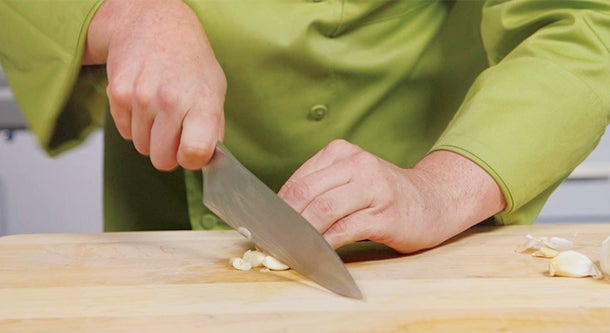5 Cooking Tips You’ll Use Every Day

Here are some very useful tips that can use every day in the kitchen. These should make basic tasks easier and help you get the most impact from every ingredient. Hopefully, these will make you want to pick up a knife or a pan and start cooking!

1. Know When to Slice, Chop or Purée Garlic
As a members of the allium family, garlic has powerful heart- and cancer-protective benefits. How you prep garlic is critical for the creation of allicin, the component of garlic that has shown promise in helping to prevent cancer and heart disease. Chopping or crushing garlic releases the enzyme alliinase, which reacts with the chemical alliin to form allicin. To get the most out of garlic’s health benefits, chop or crush garlic cloves (the finer, the better) to join the active compounds and let them sit for 10 to 15 minutes before cooking.
First, peel the garlic. Trim the hard nib from the bottom of the bulb and then roll the bulb against a non-stick mat (which lives under my cutting board). This will remove the skin without touching the flesh.
Next, decide whether to slice, chop or mince it. If you’re looking for texture and a little bit of a nutty flavor, slice the garlic about 1 millimeter thick across. It adds a nice mouthfeel to recipes and looks visually interesting.
Related: How to Choose a Kitchen Knife
When you’re making a quick or sautéed recipe, the best way to maximize the spicy garlic flavor is to finely chop it. This can be added near the end of high-heat cooking and give clean garlic spice to your dish.
When your making long-cooking dishes such as soups and stews, you should use minced or pureed garlic. To do this, chop garlic on the cutting board, sprinkle some coarse salt over it and use the back of the knife to grind or puree right on the board.

2. Turn Your Pan into a Nonstick Surface
This is a simple enough tip, but may people put oil into their pans and then heat up on the stove. Always place the pan on the stove, turn on the heat to medium, and, once the pan is hot, add oil. Count to five, and then add whatever foods your going to sauté or pan fry to the hot oil. Try to allow your foods to be as close to room temperature as safely possible. One of the reasons foods stick to a surface is because of a too great a temperature difference.

3.Know When to Use Extra Virgin or Pure Olive Oil
Many people use extra virgin olive oil for high heat sautéing and frying. While in some countries extra virgin olive oil is plentiful and cheap, in most places its much more expensive than pure olive oil.
If you buy good quality oils, the only difference between the two is the first and second press. If you use extra virgin olive oil when cooking, the high heat destroys the fruit flavour. Also, if you add it to a to hot pan, the sugars in the fruit can burn and create a bitter taste. Pure olive oil has the same health benefits and is better for higher-heat cooking. Use extra virgin oils to pour over salads or even warm pasta; the full fruit and flavor attributes will be maintained. That’s why you pay more for extra virgin olive oil in the first place.

4. Make Perfect Scrambled Eggs and Omletes
To achieve the fluffiest eggs ever, add 1 tablespoon of water to beaten eggs right before adding to the pan. If the pan is hot enough, the water in the egg mixture will create a burst of steam when it hits the pan. This will leaven the eggs and form a fluffier, lighter scramble or omelet.

5. Create a Perfectly Balanced Vinaigrette
When you make a simple vinaigrette you combine an acid and oil. Then, you add a flavor and seasoning. Start with the vinegar and add your flavor agent such as a fresh or dried herb. If using dry herbs, you can gently warm the vinegar up to help release the oils and flavor from the herbs. Fresh herbs will flavor the vinegar without the heat.
Related: A Simple Vinaigrette
Once you’ve added the flavor agent to the vinegar, add the salt and pepper. Whisk the vinegar well until the salt has dissolved and the pepper has begun to release its flavor. If you add the flavor agents and salt after the oil and vinegar have been combined, the oil will coat them and hide their flavor. Now that the vinegar is seasoned, whisk the oil into the vinegar for a well-seasoned, balanced flavor.